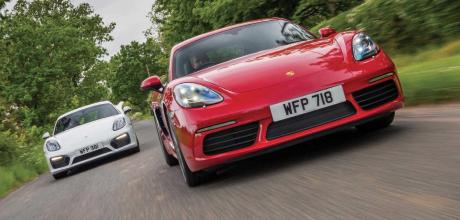Porsche 718 Cayman 2.7 981C against a 718 Cayman 2.0 981C
In a battle of base models, we pitch a 981 Cayman 2.7 against a 718 Cayman 2.0, amounting to a normally aspirated 2.7-litre flat-six versus a turbocharged two-litre flat-four. Market behaviour and enthusiast wisdom says six is best, but is this really the case?
Words Steve Bennett
Photography Dan Sherwood
FOUR INTO SIX
Base-model battle: 981 2.7 versus 718 2.0.
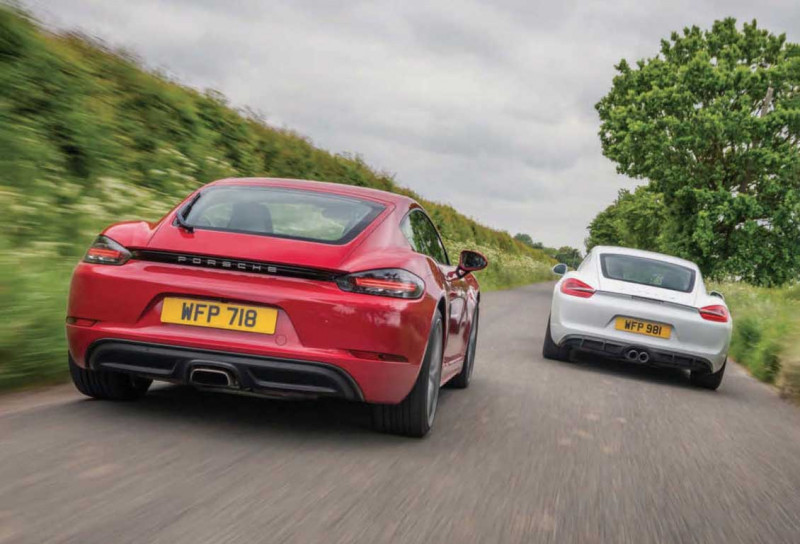
Remember the fuss, the wailing, the anguish? Okay, it wasn’t quite on par with the Porsche faithful’s response to the Cayenne all those years ago, but the notion Porsche would develop a turbocharged four-cylinder engine for the Boxster/Cayman twins didn’t land at all well. What exactly was our favourite sports car manufacturer supposed to do, though? Faced with the ongoing onslaught of EU emissions regulations and a mandatory across-the- range target to achieve, something had to give. Pragmatic Porsche took the decision to cut the Boxster/Cayman’s cylinder count and add a snail-shaped bhp booster to maintain engine output at a respectable level.
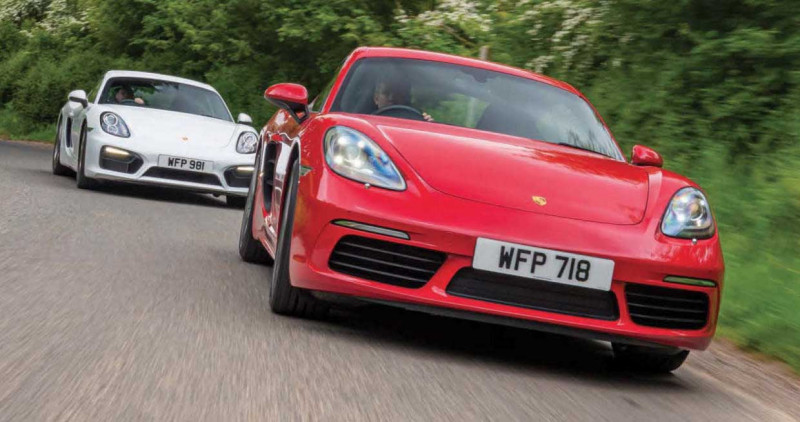
At one point, the rumour mill was spinning up stories of Porsche raiding the Volkswagen Group parts bin and dropping in the ubiquitous two-litre, turbocharged four-cylinder engine powering — in varying states of tune — everything from a boggo Seat to the Golf R. Due to Porsche being Porsche, the decision was made to develop a turbocharged flat-four (in both two-litre and 2.5-litre variants) to replace the Boxster/Cayman’s 2.7-litre and 3.4-litre normally aspirated flat-sixes.
THIS CARMINE RED 718 IS FOR SALE WITH WILLIAM FRANCIS AT A BILLY-BARGAIN FRACTION OF ITS ORIGINAL RETAIL PRICE
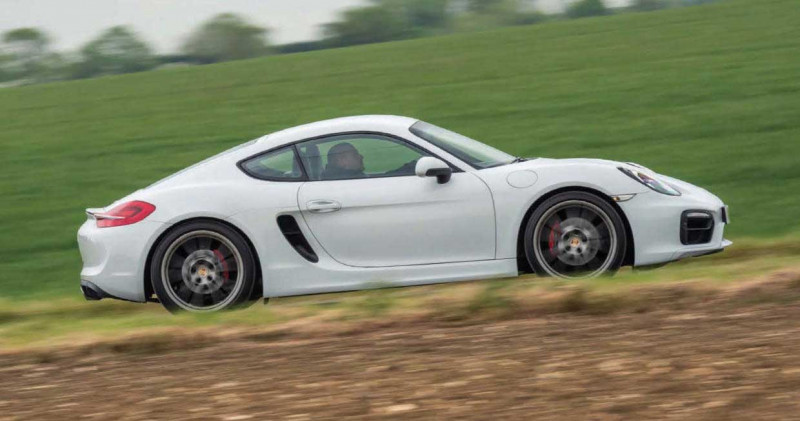
You could (and many did) claim this newly developed Porsche flat-four as essentially the flat-six minus a couple of cylinders. Porsche’s engineers, however, will tell you it was a massive development job, one carried out in conjunction with the design and development of the three-litre turbocharged flat-sixes arriving with the second-generation 991, marking another capacity downshift brought about by those pesky emissions regulations. It’s true to say this generation of fours and sixes share a significant proportion of common parts, but the flat-fours required plenty of bespoke engineering.
WITH FORCED INDUCTION ON THE MENU, PORSCHE DELIVERED TWO ENGINES, EACH MORE POWERFUL THAN THOSE THEY REPLACED
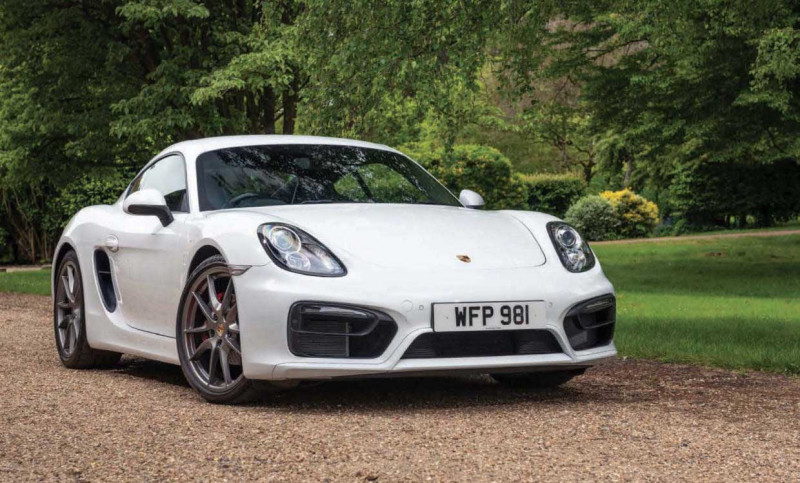
In all reality, the notion of abandoning the horizontally opposed cylinder concept was never going to fly. Bar the front-engined 924, 944, 968 and 928, Porsche’s sports cars have always been this way, and four came way before six. In an attempt to reinforce this message, and as a way of connecting new Porsches with its tangible flat-four heritage, the company morphed from 981 Boxster/Cayman to 718 Boxster/ Cayman with a badging exercise referencing the Type 547-powered Porsche race cars designed by Wilhelm Hild and put to work in the late 1950s and early 1960s. This didn’t fly with hardcore Porschephiles, who cynically saw the move as a discreditable way of Porsche trading on past glories.
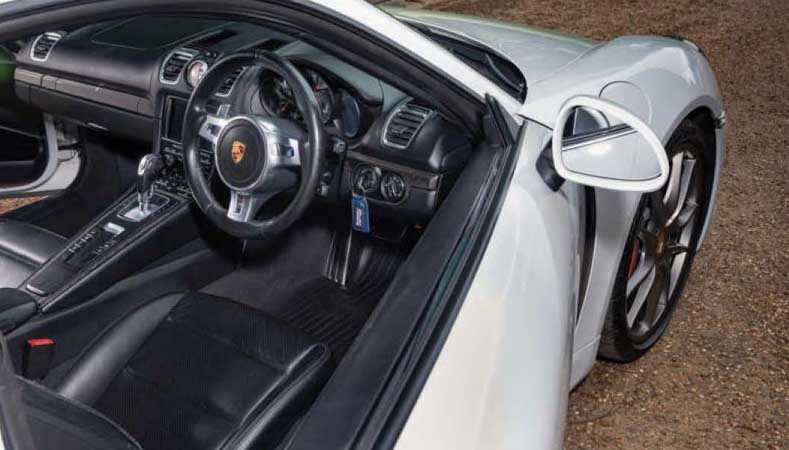
In some respects, the company was ahead of the curve (not unusual). It’s not as if other manufacturers weren’t faced with the same problem. Nobody moans about the turbocharged four-cylinder engine propelling the Alpine A110. And what of the Lotus Emira? It’s anticipated the incoming, turbocharged, four-cylinder version will be the range’s sweet spot, favoured over the heavier V6. Even Ferrari has adopted downsized-and-turbocharged power units. Adapt to survive.
Unsurprisingly, with forced induction on the menu, Porsche delivered two engines, each rather more powerful than those they replaced: 295bhp for the twolitre four and 345bhp for the 2.5-litre version, a step up from the 270bhp and 320bhp for the outgoing 2.7-litre and 3.4-litre normally aspirated flat-sixes.
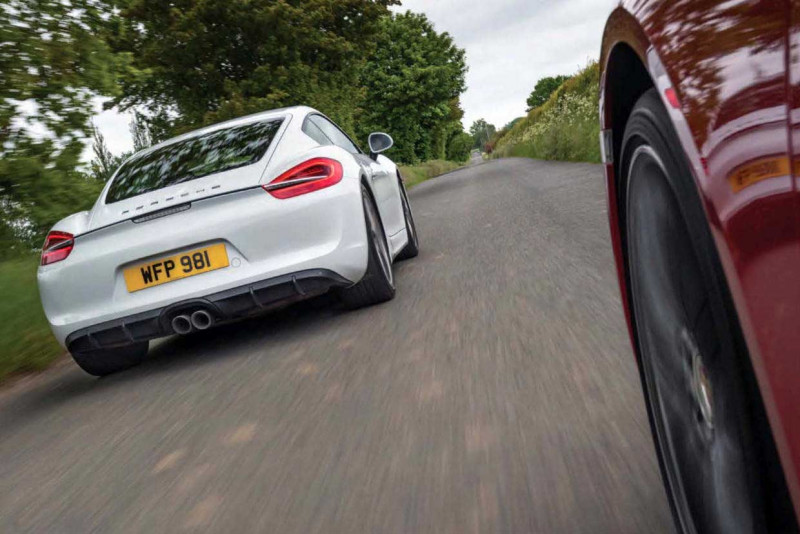
The force-fed flat-fours also produced significantly more torque, up 66lb-ft for the two-litre and 37lb-ft for the 2.5. The latter featured a more sophisticated variable vane turbocharger. More power, more torque. What’s not to like? Well, in a word, noise. The physics of acoustics make a flat-six sound sonorous and smooth, while a flat-four sounds like, well, a tractor. This is certainly what the 718 Boxster/Cayman sounded like to the Porsche purist, such is the emotional attachment and sheer legend of the flat-six soundtrack. What about power delivery, chassis dynamics, handling and braking? Concern about these vital aspects of a sports car seemed to be lost in the noise concerning the, er, noise.
We’re now more than seven years on from the 718 Boxster/Cayman launch. It is, perhaps, time to revisit the transition from six to four, not least because my own experience with the 718 has consisted of a solitary drive in a base two-litre Boxster, albeit a memorable trip involving a visit to Porsche’s Gmünd roots and a blast up the Grossglockner Pass. At the time, I was convinced the entry-level 718 was a dynamically better car than the discontinued 2.7-litre 981 on just about every level. Was I right? Thanks to our friends at independent Porsche sales specialist, William Francis, we have the perfect opportunity to find out. As you can see from the photographs on these pages, we’ve been loaned a last-of-the-line 981 Cayman 2.7 and a first-of-the-line 718 Cayman two-litre. Both cars were built in 2016.
To be straight here, that’s a 2.7-litre, 270bhp normally aspirated flat-six versus a two-litre, 295bhp turbocharged flat-four. Both cars make use of PDK transmission and both are reasonably highly specified from factory, although it’s true to say the ultra-white 2.7 offers more in the way of luxury equipment, which we will come to shortly.
The one-owner 718 has a mere nine thousand miles on the clock and, so William Francis boss, Charlie Wildridge tells us, is retailing at £41,995. The 981, meanwhile, has covered a considerably higher eighty-five thousand miles and is consequently yours for ten grand less. If there was parity in mileage, however, then as far as values are concerned, the 981 wins by some margin, given its ‘last of the flat-six status’ for Boxster/ Cayman models outside the GT stable. Now, I love a Cayman, and I particularly like a base-spec Cayman, which came in both 2.7 and 2.9 guises before the turbocharged two-litre variant.
Why do I like entry-level Porsches? Simplicity: less is more. I would always opt for basic specification, although I’d marry it with a manual gearbox. Sadly, very few folk share my vision for such purity — the first owner of this particular 981 saw fit to throw a whopping forty thousand quid’s worth of extras at it. Then again, navigating through Porsche’s individual equipment lists is something of an artform. Besides, these days, a new Porsche’s retail price is kind of irrelevant — it seems all showroom visitors care about is whether they can afford the monthly payments.
There’s no arguing about whether the factory GTS styling kit looks the business. The dark grey twenty-inch wheels are a great contrast to the white paintwork and are kept in check by Porsche Active Suspension Management (PASM), while the tasty Power Kit gives a notional (if not especially noticeable) additional ten horsepower, enhanced by Sport Chrono Package Plus to sharpen throttle response and damping.
Oh, and there’s Porsche Active Drivetrain Mounts (PADM), which sound great in theory, but accordingto Charlie, are not so great in practice, certainly when they need replacing at £1,000 a pop. This is something he has to do on a fairly regular basis, albeit primarily when working on 991- and 992-generation 911s, which give the mounts more work to do.
And there’s more (a lot more). Heated Sport seats, carbon-fibre trim, the list goes on. We’re not here to coo over such trinketry, though. It’s the driving experience that counts.
SPEAK VOLUMES
Seat time in a Cayman isn’t all about the noise coming from behind your ears, but blimey, this 981 sounds good. The exhaust crackles into life. Pull back to select first gear on the PDK selector stick. Activate Sport mode to speed up the shifts, but leave damping in Normal mode. This, as any Sport Chrono aficionado will tell you, is the best compromise for backroad blasts on less than perfect asphalt.
This 981 delivers a sublime driving experience from one of the best midengined chassis available at any price point, but there are compromises. Lauded as the 2.7-flat six might be, it’s lacking in firepower, whether the standard 270bhp or the 280bhp this particular Cayman possesses. To put it another way, the base 981 lacks the torque required to drive its almost painfully long gearing, mandated by both emissions targets and Porsche traditions. One way car manufacturers have been adapting to meet stringent legislation is by lengthening the ratios, resulting in lower engine speed during official tests.
Folk talk about lag as an issue for turbocharged cars, but revvy normally aspirated engines suffer a similar affliction when shackled to entirely unsuitable gear ratios. Torque is what you feel and drive to on the road, where skirmishes with the redline are rare and impractical. In other words, power isn’t really much good if it’s of the peaky kind. To get technical for a moment, the 981’s 2.7-litre flat-six produces 206lb-ft of torque between 4,500rpm and 6,500rpm, which isn’t a great deal and is hampered by where sits is in the rev range. Sure, you’ve got all that lovely flat-six noise (especially when you work the engine to power beyond 4,500rpm), but getting there demands navigating the dead zone before experiencing the powershift. If the 981 2.7 had closer gear ratios, then it would be an entirely different beast, but as it stands, the engine and gearbox combo are the weak link.
To the Carmine Red (a special colour option) 718, then. This Cayman isn’t quite as spec-tastic as our 981 tin-top, but it certainly looks the part, with its twenty-inch wheels, plus full leather and Sport seats. Helping compare this 718’s dynamic prowess with that of our 981 is Sport Chrono, added to sharpen things up. While it might look like a dead ringer for a late 981, almost every one of the 718’s panels are different, with folded edges and 918 Spyder-style lights, plus a crisper rear end, complete with raised Porsche script. All nice stuff for sure, but again, laying down power on the road is what we’re interested in. Specifically, the torque figure, which is almost the reverse of our 2.7-litre 981. A quick drum roll, if you please: the turbocharged two-litre 718 offers up 280lb-ft at 1,950-4,500rpm.
OFF THE CHARTS
You don’t need a degree in understanding torque curves to immediately spot what’s going on here. The turnaround is about as subtle as a boot in the behind. When the 2.7 is just coming on cam and getting its shizzle together, the grunty two-litre has quite literally disappeared up the road in all its swagger and glory, sprinting from rest to 62mph in 4.8 seconds. And while it may peak at 4,500rpm, it will smoothly rev out to 6,000rpm. No, the turbocharged flat-four isn’t quite as counterbalanced as the flat-six, but lightweight internals and less moving mass makes it a close-run thing.
Like Stacy’s mom, the 718 has got it going on exactly where and when you need it. This Cayman is faster in every situation, and the turbocharger installation is as good as you expect from Porsche, the company pretty much responsible for nailing the concept of turbocharging for the road — the 718 is devoid of any sort of lag and presents lovely engine flexibility.
I was concerned the twenty-inch wheels might be a little too big for the car’s passive suspension, but the wheel and tyre combination work perfectly here on Suffolk’s B-roads. The two-litre 718 has the power and torque to really light up the chassis, helped by its lower kerb weight (1,335kg versus the 981’s 1,395kg). To add a bit of perspective, a same-generation Cayman GT4 weighs in at 1,511kg, which is just plain lardy. Anything else? Well, yes, actually. The base 718’s brakes are awesome sixpots, whereas our 981 makes use of smaller four-piston calipers. The bigger anchors allow deeper braking dives into corners, perfect in advance of a hit of turbo and a wag of the tail on exit. Putting it all together, the 718 has a lovely sense of flow about it. This is a Cayman you can relax into. It’s a sports car asking little in return, at least when driven in a perceived normal manner. The turbocharger-enhanced flat-four doesn’t pick up smoothly from idle speed in the way of some higher-performance fours equipped with forced induction, though. It comes on song with much more of a rush, perhaps a sign of its lightweight rotational mass? It allows you to make the sort of progress epitomising a truly potent sports car. It’s laggy for a moment, but then boost comes in with real punch. The engine feels progressively angrier through the rev range. This is more of a yob to the normally aspirated 2.7-litre flat-six’s sophisticate.
The turbocharged engine gives the 718 Cayman driver more options. Some of these are to do with ease of driving around town, as well as during overtaking in traffic, but they also apply to the chassis. This is a Cayman happy to play the hooligan like none before. With all that grunt and torque on tap from low revs, it’s possible to make the rear of the Cayman much more mobile for a lot less effort than previously required. To get the rear of a 2.7-litre 981 lit-up requires a brutal lift-off oversteer technique. Unsurprisingly, it’s not really to be recommended on the road. With turbo and torque, however, once turned into the right sort of corner and with boost wound up, the 718’s rear end can be played with in much the same way as you might toy with a Toyota GR86. To be clear, I’m no sideways action hero, but with the 718, it’s almost instinctive.
Goodness, that’s quite an outpouring of reverence. Time for a reality check? Well, I can try, but it’s going to be difficult. Based on all the things I hold dear as a Porsche enthusiast and keen driver, the entry-level 718 Cayman delivers. There were once gripes regarding the electronically assisted steering, but the 991 Turbo-borrowed rack (as fitted here) is so good, you don’t register it’s lack of physical connection to the steering wheel. And yes, if this 718 was my ideal specification, it would be manual, thereby incorporating one of the sweetest Porsche gearboxes ever manufactured. Then again, PDK is now so evolved, you’re quickly won over and find yourself wondering if that selfshifting lark is all it’s cracked up to be.
PLAIN TORQUE
As far as comparing the entry-level 981 and 718 is concerned, I think I’ve more than made my point, but in isolation, the 981 Cayman 2.7 is a great car, even if it’s compromised in two crucial areas, which no amount of sonic superiority will make up for. Even before the arrival of the 718 in dealer showrooms, the 981’s torque-versus-gearing limitations were a constant frustration, irrespective of whether a 2.7-litre or 3.4-litre flat-six was at play.
Coming into this feature, when presenting me with both Caymans, Editor Furr was surprised I was planning on making a case for the 718 over the 981. Yes, I’d more or less already made my decision, even if it was based on my experiences driving a 718 Boxster many moons ago. Indeed, he suggested most Porschephiles dismiss the base two-litre 718 in favour of model variants powered by the more potent 2.5-litre flat-four (he’s a big fan of the 718 Cayman GTS), which seems to have gained more acceptance. Looking at Porsche chatter online, this certainly appears to be the view, but how many folk have actually driven a two-litre Cayman or Boxster?
Obviously, both myself and Mr Furr have first-hand experience to rely on when casting our judgments, but take a look at the currently available number of two-litre models in the classifieds and you’d have to conclude not many critics of these cars have actually spent time behind the wheel.
Not doing very well here, am I? C’mon, though — Porsche rarely makes cars worse (although it is guilty of making them too big). Let’s drill down to the conundrum and comparison of a normally aspirated flat-six against a turbocharged flat-four. Technically, it would be perverse to champion the four over the six. After all, the bigger engine is smoother, better balanced and, as mentioned earlier, clearly the more sophisticated offering. It also sounds great. Indeed, it sounds like a Porsche, but then isn’t what we are hearing simply the noise of a six-cylinder engine, known for singing a different tune?
The force-fed flat-four maybe two cylinders short, and there’s no denying it’s gruffer and less refined (to a degree), but this is the nature of the beast. With its turbo philosophy, however, it transforms the performance of what is — remember — a base-model Cayman. It animates the chassis, getting it moving in a way the torque-shy 2.7 simply cannot. I realise I haven’t really mentioned the sonic calling card of the flatfour. Yes, it really does sound a bit agricultural at idle, not helped by the ticking of the direct injection system, but on the move, this Porsche has a character all its own. Blasting along Suffolk’s highways and byways, the 718 sounds more like a Subaru Impreza rally machine than one of Zuffenhausen’s sports cars. Pop, bang, whoosh! Forget the Porsche heroes of old — in the two-litre 718, you can be Colin McRae. What was it he used to say? Ah, yes. “If in doubt, flat out.”
There it is, then: the flat-four-propelled 718 Cayman doesn’t sound as good as the flat-six-powered 981 Cayman, which is kind of where we came into this story. There, I’ve said it, but this is the only criticism I can level at a car demonstrably better than its predecessor in every other respect. At the time of writing, this Carmine Red example is for sale with William Francis at a Billy-Bargain fraction of its original retail price. As Charlie will happily attest, he can sell 981s all day long, but echoing Editor Furr’s words, the market is shunning the 718, particularly in two-litre form. It might just be my opinion, but the market has got it wrong.
Here’s a thought, a plea even. I’ve often thought (obsessed over, in fact) there is a yawning gap in the Porsche range for a sub-Boxster roadster. A car much smaller and more lightweight, in the spirit of the previously mentioned Alpine A110. A real nod to the 718 racers of yesteryear by way of Porsche going back to its roots and offering a true enthusiast’s sports car. Granted, it’s hard to build such a thing these days, but wouldn’t we all go mad for such a steed? Where there’s a will, there’s a way. Talking of which, imagine the goodwill such a gesture would engender. A true altruistic act from a manufacturer commanding respect and devotion like no other.
The perfect engine for such a machine? How about a super-compact, lightweight, turbocharged two-litre flat-four? It’s a good job Porsche has one on the shelf. Yep, it’s the perfect engine for the job, but right now, it’s in the wrong car. Go on Porsche, give something back. It’s a win, win situation, surely?
Above The market has yet to wake up to just how good the two-litre 981 is, even if the noise isn’t as satisfying as the classic flat-six growl
Above William Francis in Bury St Edmunds has both cars for sale, but which of these Porsches would you choose to take home?
Above Both Caymans were built in 2016, making the 981 one of the youngest of its kind, the 718 one of the oldest.
Above For some, a normally aspirated flat-six is the undisputed champion of Porsche power units, even though the company has been making use of four-cylinder engines ever since its inception seventy-five years ago.
Above It may have only two litres of displacement, but base model 718 makes use of forced induction, giving the 981 a run for its money in every sense.
Above One of the last 981s built and therefore one of the last non-GT Caymans powered by a normally aspirated flat-six powerplant.
Above and below Our feature 981 is a base model 2.7, but was optioned with various GTS add-ons by its original owner.
Above It may have only two litres of displacement, but base model 718 makes use of forced induction, giving the 981 a run for its money in every sense. Above One of the last 981s built and therefore one of the last non-GT Caymans powered by a normally aspirated flat-six powerplant.


